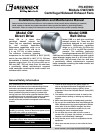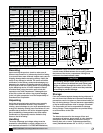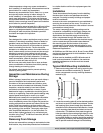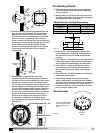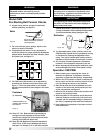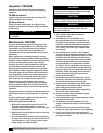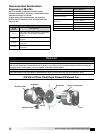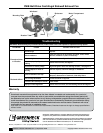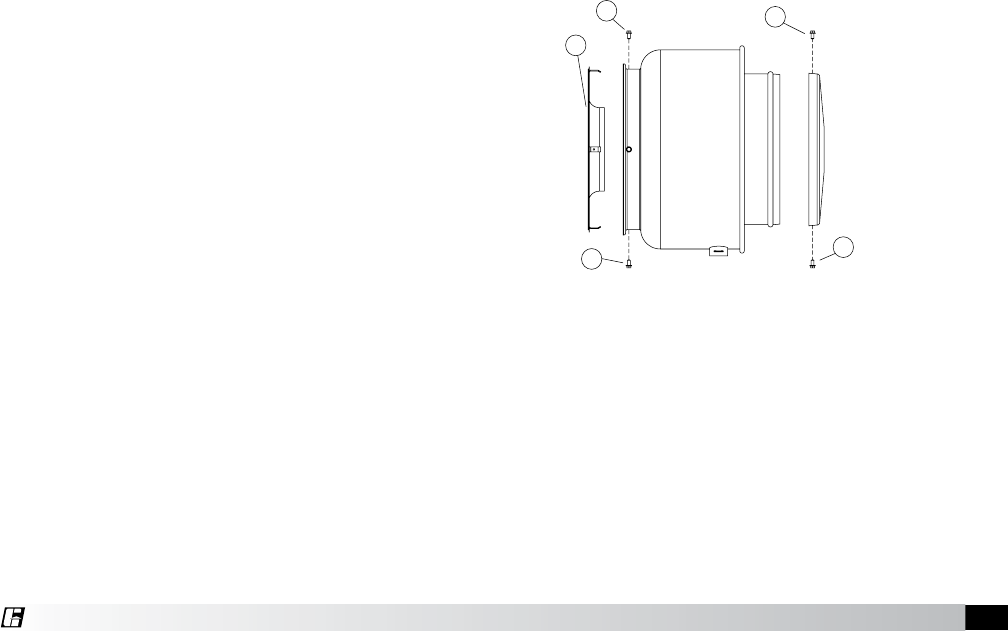
3
Model CW/CWB • Centrifugal Sidewall Exhaust Fans
®
(wide temperature swings may cause condensation
and “sweating” of metal parts). All accessories must be
stored indoors in a clean, dry atmosphere.
Remove any accumulations of dirt, water, ice, or snow
and wipe dry before moving to indoor storage. To
avoid “sweating” of metal parts, allow cold parts to
reach room temperature. To dry parts and packages
use a portable electric heater to get rid of any moisture
buildup. Leave coverings loose to permit air circulation
and to allow for periodic inspection.
The unit should be stored at least 3½ in. (89 mm) off the
floor on wooden blocks covered with moisture proof
paper or polyethylene sheathing. Aisles between parts
and along all walls should be provided to permit air
circulation and space for inspection.
Outdoor
Fans designed for outdoor applications may be stored
outdoors, if absolutely necessary. Roads or aisles for
portable cranes and hauling equipment are needed.
The fan should be placed on a level surface to prevent
water from leaking into the fan. The fan should be
elevated on an adequate number of wooden blocks so
that it is above water and snow levels and has enough
blocking to prevent it from settling into soft ground.
Locate parts far enough apart to permit air circulation,
sunlight and space for periodic inspection. To minimize
water accumulation, place all fan parts on blocking
supports so that rain water will run off.
Do not cover parts with plastic lm or tarps as these
cause condensation of moisture from the air passing
through heating and cooling cycles.
Fan wheels should be blocked to prevent spinning
caused by strong winds.
Inspection and Maintenance During
Storage
While in storage, inspect fans once per month. Keep a
record of inspection and maintenance performed.
If moisture or dirt accumulations are found on parts,
the source should be located and eliminated. At each
inspection, rotate the wheel by hand ten to fteen
revolutions to distribute lubricant on motor. If paint
deterioration begins, consideration should be given to
touch-up or repainting. Fans with special coatings may
require special techniques for touch-up or repair.
Machined parts coated with rust preventive should be
restored to good condition promptly if signs of rust
occur. Immediately remove the original rust preventive
coating with petroleum solvent and clean with lint-free
cloths. Polish any remaining rust from surface with
crocus cloth or ne emery paper and oil. Do not destroy
the continuity of the surfaces. Thoroughly wipe clean
with Tectyl
®
506 (Ashland Inc.) or the equivalent. For
hard to reach internal surfaces or for occasional use,
consider using Tectyl
®
511M Rust Preventive, WD-40
®
or the equivalent.
Removing From Storage
As fans are removed from storage to be installed in their
nal location, they should be protected and maintained
in a similar fashion until the fan equipment goes into
operation.
Installation
These fans exhaust directly away from the building,
therefore their location and placement should be
analyzed. Proximity to nearby buildings and people
must be considered.
Access to the motor compartment is accomplished by
removing the screws from the cover. The cover can
then be removed and placed on a flat surface in an area
protected from strong winds.
The motor’s amperage and voltage rating must be
checked for compatibility to the supply voltage prior
to final electrical connection. For NFPA Restaurant
Applications, the electrical supply must enter the
motor compartment through the breather tube. For
other non-flammable applications the electrical supply
can be routed through the conduit chase between
the mounting plate and the bottom of the motor
compartment. Consult local code authorities for your
specific requrements. UL/cUL 762 Installations are for
Restaurant Applications.
All CWB fans and CW fans with A, B and C motor RPMs
are the only fans approved for this installation. All must
include the suffix “G”.
All fans must be installed per NFPA 96 and meet all
local code requirements. In addition, the maximum
operating temperature at the fan must not exceed
375°F (191°C).
Typical Wall Mounting Installation
1. Remove mounting plate from unit by removing the
fasteners shown above marked by (1). Remove
motor compartment cover by removing fasteners
marked by (2).
2. Locate the mounting plate (3) at the desired position
and check to avoid unit clearance problems. Cut the
wall opening (4) as shown based upon dimensions
obtained from the Dimensional Data Section. Locate
top of mounting plate (decal) and attach to the wall
construction. The fasteners must pass through the
holes provided in the mounting angle clips (5) on the
mounting plate (3). For uneven surfaces, shims may
be required. Sealant or caulking should be applied in
the groove (6) formed by the mounting plate and the
wall to prevent moisture leakage into the building.
1
2
3
1
2



